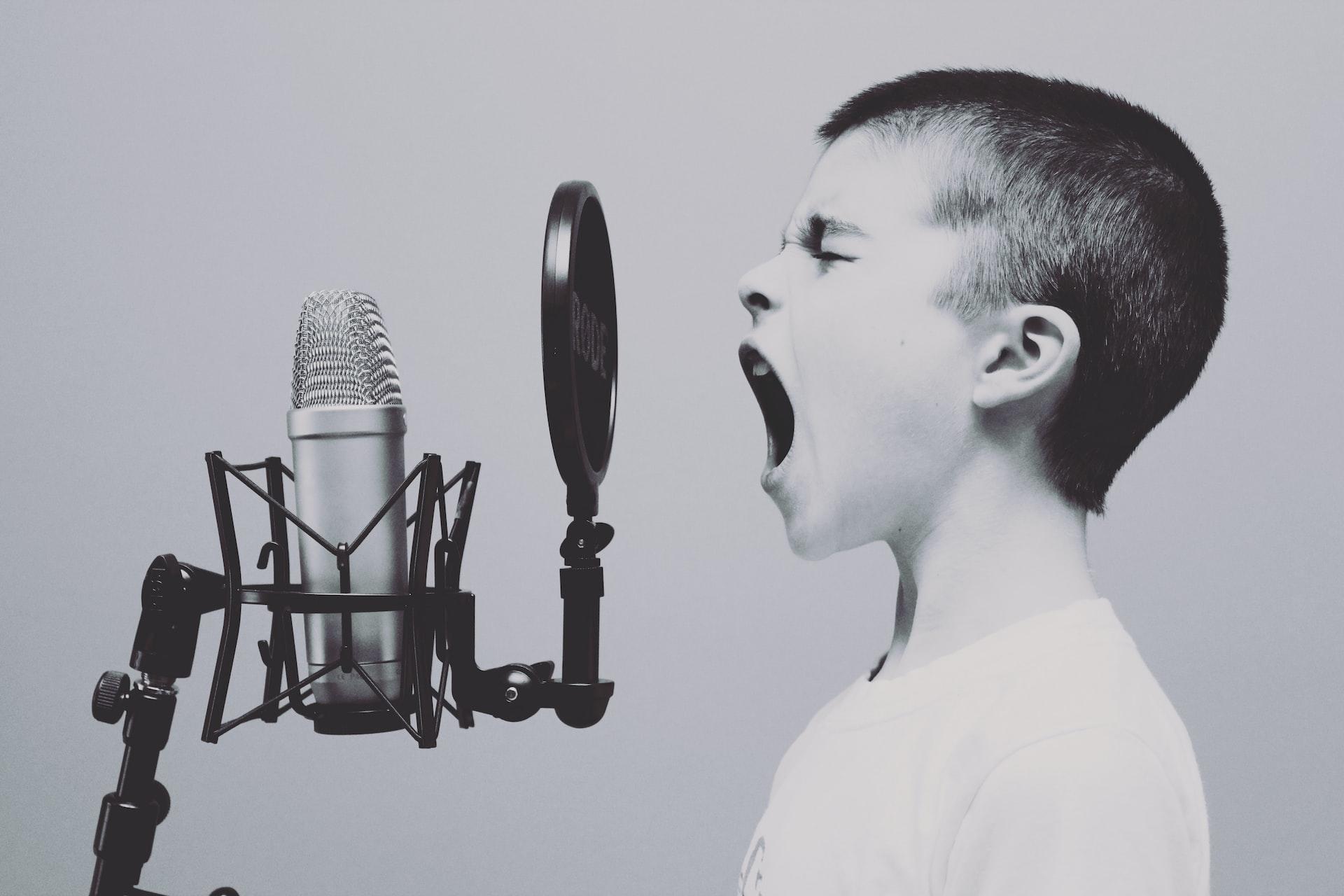Singing is a special category of skill because you don’t require any equipment or tools to do it.
While you can benefit greatly from a singing teacher or voice coach, you can also learn how to sing quite well on your own.
There are many self-taught singers out there in the world, and many even become quite renowned. You can always enlist a voice coach later on in your singing career if you’d like!
With some simple techniques and methods to practice on your own, you can become quite an accomplished singer without any coaching.

Vocal Skills
There are several vocal skills and concepts that every singer should be familiar with.
Being aware that these things exist is one huge hurdle to overcome when learning how to sing. People have taken a lot of time to philosophize, study, think, ponder, and talk about music. The result: very particular definitions for very particular terms.
It helps experts to be able to exactly say what they mean, but it can be confusing for beginners. Just have patience and trust that with time you will gain a better understanding of the many different keywords in the singing world.
Vocal Tone (aka Timbre)
Tone is the personal element of a note that only you can give. It is the sound of what you are singing.
If you have a room full of people and they all sing the same note, each one will sound different because of everyone’s unique tone. It’s all the same note, the difference is the subtle quality that is connected to the fact that each person’s voice and physical anatomy are different.
This is the quality of a voice that is very subjective; there are no set words to describe it. You might say someone’s vocal tone is whispery, brassy, bold, smooth, bright, breathy, dark, nasally, gravelly, or any other adjective that you want to use.
Musical Tone
Musical tone is what you are singing.
Where vocal tone is unique to each person, musical tone is standardized.
Everyone can sing the same scale, so they will have the same musical tone.

Pitch and Key
The Key is what you intend to sing in and Pitch the actual note you make. If you sing a note a little bit wrong, you can say that it was off-pitch, but because it was close enough to what was intended, it’s still on key.
If you sing notes that are wildly off-pitch and change the tune to something unrecognizable, then you are singing off-key.
Tune
The tune is a series of notes that are easy and pleasant to remember, like “Twinkle Twinkle Little Star.”
Many people say they want to sing “in tune” when what they really mean is they want to sing “on pitch.”
Range
There are six main types of voices based on range. Range is the scope of notes you can comfortably sing.
- Soprano: The highest female or young boy (called treble) voice. It typically covers C3 to C6, but can extend as far as B3 to G6.
- Mezzo-Soprano: The second-highest classification for females and young boys, and the most common. It typically covers A3 to A5, but can extend as far as G3 to C6.
- Alto: The lowest female vocal type. It typically covers from F3 to F5, but can extend as far as D3 to A5. It is rare for a female voice to get as low as D3.
- Tenor: The highest adult male vocal type, it covers from C3 to C5, but can extend as far as B2 to F5.
- Baritone: This is the most common type of male voice. It covers from G2 to G4, but can extend as far as F2 to C5.
- Bass: The lowest vocal type, it covers from E2 ro E4, but can extend as far as C2 to G4.
With practice, you might be able to unlock more of your vocal range.
Singing is my passion, my first love and the secret of my energy. Music to me is like finding my inner self, my soul. It gives me a great joy to see audiences enjoying with me. I have given my heart to singing. When I sing, I can feel romance in everything around me.
- Kailash Kher
Diction
Diction in singing is the same as enunciation and pronunciation in speaking.
The way you say certain vowel and consonant sounds in singing is usually different than if you were speaking them. This means you need to learn the way you want to sing a certain sound to get your point across.
One of the most easy-to-understand examples of this is the pop-punk music genre.
Take a listen to “All The Small Things” by Blink-182.
Right away, we notice that the way they sing “things” and “brings” is different from how you’d normally say them while talking.
This trend carries on through the song; long, drawn vowels. This affectation is prevalent in the pop-punk genre.
Articulation
Articulation is how you move your mouth, lips, cheeks, tongue, jaw, and larynx (the speech organs) to achieve sound.
You can see that a lot of singers move their mouths in odd ways while singing, and this is because they need to create the perfect shape in their vocal tract to hit the note they want.
Articulation is affected by the teeth, hard and soft palettes, nasal passages, hydration, body weight, dryness of the air, and other factors that influence the state of the organs that make sounds for speaking and singing.
Understand all these concepts and more about singing when you take professional singing lessons on Superprof.

Technical Skills
Now that you know a little about different concepts, it’s time to dive into some technical aspects of singing.
One of the beautiful things about singing is that each person gets to decorate their voice any way they like. Using flourishes and ornaments, plus the vocal skills mentioned above, a singer can create a unique sound of their own.
Vibrato
One of the most noticeable and widespread vocal ornaments is vibrato. This is when a singer allows their voice to “shake” in such a way so that it sounds purposeful.
While vibrato can happen by accident, especially if the singer is straining, it’s best to be done only on purpose with control, otherwise, you risk damaging the vocal folds or singing off-pitch.
There are a lot of different techniques to achieve vibrato, so you can find a way that works best for you.
Get assistance with vocal exercises and enhancing your voice with singing lessons Adelaide.
Glissando and Portamento
Glissando and portamento are two very similar vocal flourishes, but they have a slight, distinct difference.
A glissando refers to changing from one note/pitch to another and hitting every distinct note in between. In terms of colour, you could think of it as swatches that change from red to yellow. There is a distinct yellow swatch, a distinct red swatch, and a handful of orangey swatches in between.
You know exactly where one swatch (pitch) begins and ends.
A portamento refers to changing from one note/pitch to another but without making distinct pitches in between. In terms of colour, you could think of it as a gradient between two colours. For example, red and yellow. There is a distinct yellow end and a distinct red end, but all the colour in between changes so gradually that you can’t tell exactly where one shade of orange begins and ends.
A good musical example of both portamento and glissando is the beginning of “Ain’t No Other Man” by Christina Aguilera. When she belts out “Heyyyy….” her pitch slides seamlessly up from note to note to note, which is the portamento.
Right after, she dances her pitch down, hitting the notes distinctly in between. This is the glissando.

Registers
Before, we talked about vocal ranges. Registers are a similar idea, but they are different affectations you can give to your voice to change the notes you are singing.
In order of lowest to highest, they are
- Vocal fry
- Chest voice
- Head voice
- Whistle register
Some people can access multiple registers with ease. Others, not so much. The vocal fry and the whistle register are the hardest for most people to reach, with the whistle register being extra rare.
Learn to practice the registers you can reach. Typically, most people can use their chest voice and head voice (where falsetto lives) with relative ease.
Breathing
Breathing is extremely important in singing.
If you don’t breathe well enough, your notes won’t have much strength behind them, you might run out of air mid-singing, and you could even pass out!
Breathe too deeply and you lose control of your voice.
Breathe at the wrong time and it interrupts the flow of the song.
You also want to be sure that you breathe from the diaphragm, instead of trying to keep all the air high up in the chest.
Projecting and Belting
Being able to sing with power falls under the umbrella of vocal control. Many people sing easily in breathy, whispery styles because it’s easier to achieve than a powerful voice.
Projecting means being able to send your voice far and wide. It’s not just about volume, it’s about how far your voice will carry. Finding a good resonance no matter what register you’re singing in and sending it to the back of the concert hall is a good projection.
Belting is more specifically when a singer sends a strong pitch from the place where their head voice and chest voice meet or overlap.
Vocal power comes from a delicate balance between breath and muscle. The muscles that are the diaphragm and the vocal cords (aka folds) need to be strong enough but not too strong. The breath needs to be not too much and not too little.
The sweet spot in the middle allows you to project and belt your voice without strain or risk of cracking your voice.
Learn to control your voice with singing lessons Melbourne on Superprof!

What Exercises to Practice
The most common and important exercise for singing is simple warm-ups.
To practise musical and vocal tone, try a 5-Tone Count exercise. First, find your comfortable volume by saying “One” out loud at that comfortable volume. Then find a note at the bottom of your register (try a C3 or G3) and sing the word “One” on that pitch. Sing the numbers One through Five on a 5-Tone scale and keep each note as strong as the last.
To practice your range, you can use a piano to help you take step notes up and down to find the limits of your comfortable singing boundary. Find the middle C (C4) on the piano and match the pitch with a comfortable volume. Press the keys one at a time going lower in pitch, matching the sound each time. When you feel croaky or can no longer make a vocalisation because you’re too low, that’s the end of your vocal range. Repeat the same exercise going up higher and stopping when you feel strained or squeaky.
Where to Learn More
To help you learn and practice, you can seek out helpful materials online.
YouTube
YouTube is always the number one place to find Singing lessons online free. You won’t receive personalised attention, but there are so many creators uploading content daily that you are bound to find a creator you click with and learn from with ease.
Listen to Music
What better way to practice singing than by emulating artists you love? Practice singing songs that speak to you, working to hit the pitch and rhythm just like the singer.
As you develop your own voice, you will be better able to sing either just like that singer or in a way that suits your voice better. Either way, you will be familiar with how it feels to perform that song.
Singing or Vocal Coaches
There are plenty of vocal or singing coaches just waiting for you to find them. For example, you can find in-person or online singing lessons right here on Superprof.
The caveat is that these classes can be cost-intensive.
If you want someone who can help you increase your progress faster, more efficiently, and with expertise, this is the way to go.
You might be able to find a coach who can work with you on a sliding scale or in group lessons rather than private ones in order to make classes a bit more affordable.
There is a lot to learn about singing, but fortunately, you can teach a lot of the basics to yourself at home. Time to get singing!
















